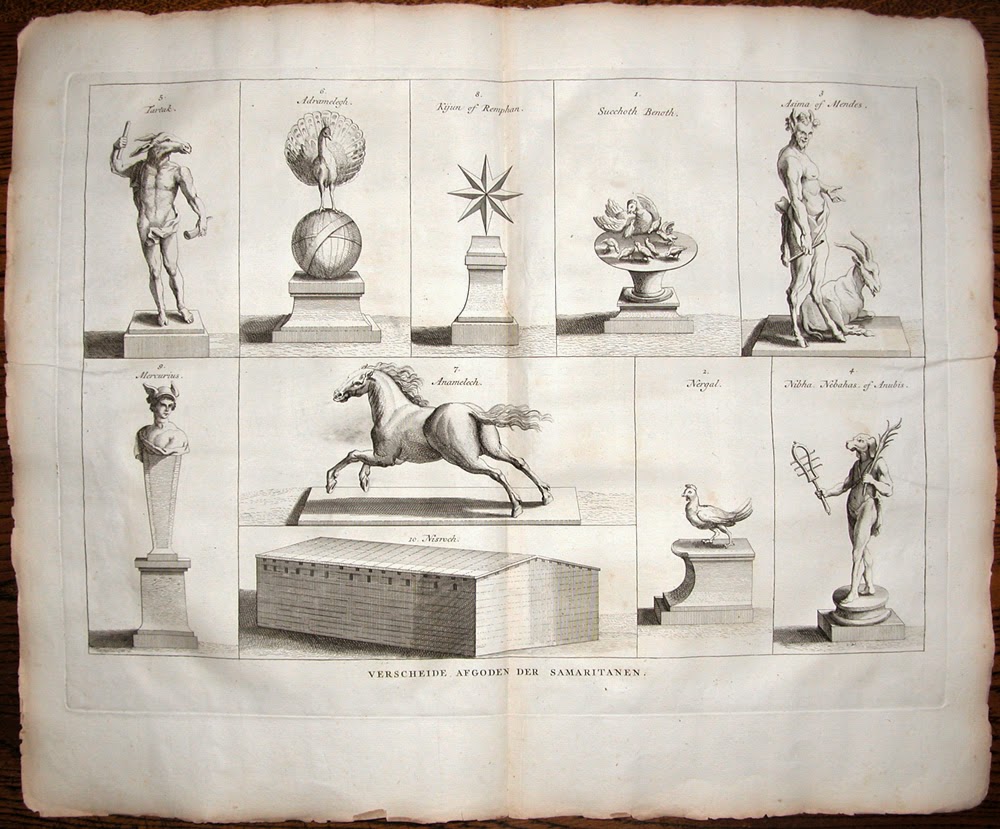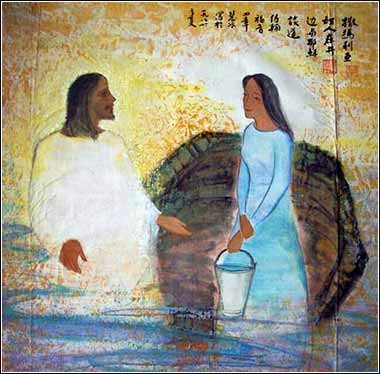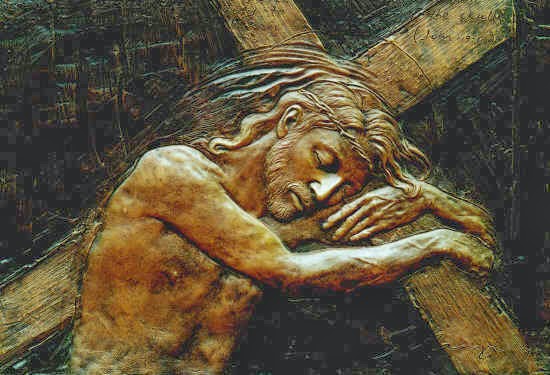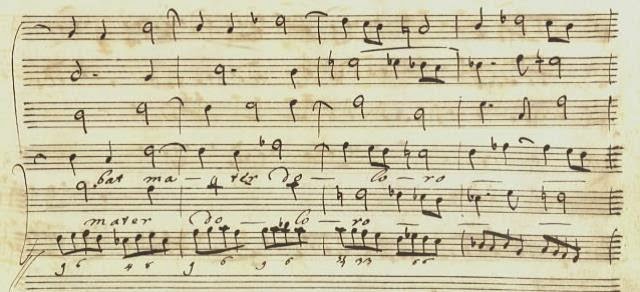 The Western Church presents a triptych of readings on Sundays 3, 4, and 5 of the "Year A" cycle of Lenten readings in the ordinary form--readings that are so iconic to the spirit of Lent and the regeneration of souls, that the Rite of Christian Initiation of Adults (RCIA) prescribes them to be read every year (in years "B" and "C" as well) when catechumens are present and the pre-baptismal exorcisms ("scrutinies") are pronounced over them. Along with this week's reading of the "Woman at the Well", next week we will hear about the "Man Born Blind", and the week after, the "Raising of Lazarus". From these three readings, the Lord is seen as one who has the power to turn the barren soul fruitful in right worship, to give enlightenment to the blind, and finally, to raise the dead to life. All of these mighty works are achieved in their recipients by the acceptance of our Lord in faith as the Messiah.
The Western Church presents a triptych of readings on Sundays 3, 4, and 5 of the "Year A" cycle of Lenten readings in the ordinary form--readings that are so iconic to the spirit of Lent and the regeneration of souls, that the Rite of Christian Initiation of Adults (RCIA) prescribes them to be read every year (in years "B" and "C" as well) when catechumens are present and the pre-baptismal exorcisms ("scrutinies") are pronounced over them. Along with this week's reading of the "Woman at the Well", next week we will hear about the "Man Born Blind", and the week after, the "Raising of Lazarus". From these three readings, the Lord is seen as one who has the power to turn the barren soul fruitful in right worship, to give enlightenment to the blind, and finally, to raise the dead to life. All of these mighty works are achieved in their recipients by the acceptance of our Lord in faith as the Messiah.
Parenthetically, in the Orthodox Church this reading is part of the Easter ("Pascha") cycle, and the woman at the well is given a name, St. Photini (the 'enlightened one'). She was considered "equal" to the apostles, as the first to be commissioned to take the Good News of our Lord to the citizens of Samaria. While chronologically before the passion, death, and resurrection of the Lord in the Gospel of John, the importance of this reading, highlighting the clemency of our Lord in the conversion and regeneration of sinners by his saving work is clear.
 The reading begins by explaining that Jesus had been in conflict with the Pharisees. In chapter 3 of John's Gospel, Jesus revealed himself to the Jewish leader Nicodemus as
nothing less than the 'Son of God' through whom one must be 'born again'
to have eternal life. Nicodemus continued to respond to the Lord in
questioning ambivalence to his revelation, apparently preferring to
remain in the dark, than to accept the transformative Love of God, which
came, not to condemn the world, but that the world might be saved
through faith in him (cf John 3:16ff). Thus, as Jesus was traveling down from Galilee to Jerusalem, (which would have necessitated his transit through the unfriendly region of Samaria and the town of Sychar,) he would not only be exhausted by the journey through the desert itself, but he would likely be suffering a certain kind of spiritual exhaustion, having failed up to that point to have gained the faith of the people and failed (so far) in fulfilling his mission of drawing all men and women into the love of God the Father. Indeed, Jesus no doubt could see that the world was full of unenlightened sinners, lost in the shadows of death, and unresponsive to the invitation of partaking in the joy of the 'Father's House'. His work would be cut out for him, if he was to reveal the love of the Father to all the world, if his own people would completely reject him--and not with scorn and persecution at this point, but through what I would argue to be the much more painful attitudes of indifference and ambivalence.
The reading begins by explaining that Jesus had been in conflict with the Pharisees. In chapter 3 of John's Gospel, Jesus revealed himself to the Jewish leader Nicodemus as
nothing less than the 'Son of God' through whom one must be 'born again'
to have eternal life. Nicodemus continued to respond to the Lord in
questioning ambivalence to his revelation, apparently preferring to
remain in the dark, than to accept the transformative Love of God, which
came, not to condemn the world, but that the world might be saved
through faith in him (cf John 3:16ff). Thus, as Jesus was traveling down from Galilee to Jerusalem, (which would have necessitated his transit through the unfriendly region of Samaria and the town of Sychar,) he would not only be exhausted by the journey through the desert itself, but he would likely be suffering a certain kind of spiritual exhaustion, having failed up to that point to have gained the faith of the people and failed (so far) in fulfilling his mission of drawing all men and women into the love of God the Father. Indeed, Jesus no doubt could see that the world was full of unenlightened sinners, lost in the shadows of death, and unresponsive to the invitation of partaking in the joy of the 'Father's House'. His work would be cut out for him, if he was to reveal the love of the Father to all the world, if his own people would completely reject him--and not with scorn and persecution at this point, but through what I would argue to be the much more painful attitudes of indifference and ambivalence.
And so, Jesus approaches the well in Sychar at the sixth hour--about noon--and finds a woman present. He asks for some water. Immediately. we recognize that the request is wrapped in a kind of triple symbolism. First: water is praised throughout scripture as the source of fruitfulness in the desert. Our first reading from Exodus 17 speaks to this. We hear in a number of important places in Isaiah (such as chapter 35 and 44) that the desert (as an icon of the parched soul) will be made fruitful by the gift of water. We hear the prophecy (Ezekiel 47) that water will flow from the temple, growing into an ever-greater stream nourishing all the nations. The psalms are replete with further examples. None other than Jesus himself had been discussing the importance of water as the means of rebirth and regeneration... Nicodemus was told that he must be reborn of water and the spirit (John 3: 5), a water that unmistakeably needs to be associated with the Sign of Cana (in John 2) where water was the precursor to a renewed celebration of the coming of the Kingdom of God in Jesus.
Secondly, we see a more subtle symbolism in the interaction of these two at the well. A man approaching a woman at a public well would have the biblical connotation of 'flirting' between the man and woman. Indeed, this would be confirmed by the progression of the conversation into the revelation of the marital status of the woman--married five times previously, and unsuccessfully joined at the moment. But this 'flirtation' is not rooted in mere physical attraction, but rather in divine love God has for his people. Make no mistake, Jesus is indeed 'wooing' this woman's affections, but in a way to satisfy her need that the world cannot give. Again, this interpretation flows from the Wedding at Cana two chapters before, where the Lord endorses marriage as a sign of the Kingdom. Flowing from the wedding bond is the new fruitfulness of the husband and wife where, according to the near-Eastern understanding of the day, the husband makes the wife fruitful in the marital bond, and the wife in turn bears children as gift to her husband. The fruitfulness of the waters and rains in the desert had the same effect-- as the waters make the earth fruitful, so to is humanity refreshed, returning glory to God, the Father of the rains.
Finally, the reading tells us that the encounter between Jesus and the woman takes place at the height of day... at the height of enlightenment, where nothing is hidden and all is to be revealed. No doubt neighbors saw the encounter and a discussion of the event would be 'news' (gossip) about the community. This foreign 'prophet' spoke (flirted) with a woman whose shame was precisely that she was not in a faithful, fruitful spousal relationship. Exposed at that noonday hour to the criticism and judgment of her neighbors, she found new strength and hope through the loving gaze of the Savior. She would not be defined by her past infidelities, but rather by a new beginning in faithful (apostolic) fruitfulness.
 |
| Samaritan Idols |
And so, the discussion quickly proceeds to a sectarian debate, apparently between the merits of Judaism and the Samaritan cult. Where is right worship carried out... on this mountain where we Samaritans observe sacred rites or in Jerusalem, where the Jews worship? 'Mr. Prophet,' who can see the desolation of my soul, how do I worship correctly? Jesus responds, "the day will come when worship will not take place on either mountain... true worshipers will worship the Father in Spirit and in Truth... and he seeks these worshipers" (cf John 4:21-23). The miracle insight of the Lord, whom the woman quickly identified as a prophet, is not in divining the marital status of the woman who had five unsuccessful marriages, but (as many scripture scholars point out) in calling out the multiple idols which the Samaritan people mixed with their Abrahamic heritage. Jesus was a prophet, precisely in the Old Testament tradition, because he called people away from their idols--from their false gods--and proclaimed the faith and power in the One, True God. On asking about the coming of the Messiah, the woman heard the clear, unmistakable proclamation from the Lord, "I am he" (John 4: 26). The one who would unite all people in right worship, satisfying all the longings of the human heart, was standing before her and revealing himself to her! And from her new-found faith, she would bear the harvest of the first-fruits of the Lord's mission to gather the nations. While "salvation comes from the Jews" (John 4:22), it does not necessarily belong to the Jews alone, but rather, as heard in chapter 3, salvation belongs to every heart that receives him and in turn becomes fruitful through him. From that point, she went forth, proclaiming the Good News to the entire village.
As the disciples return (from feeding themselves), they see the Lord at the well, conversing with the woman and later they ask him what he wanted with her. Certainly this woman could not provide him--whom they had come to know as a completely self-sufficient prophet and prodigious miracle-worker--with anything that he really needed. "They ask him, "Why don't you eat?" Jesus replies, rather cryptically, that the nourishment he seeks is not in food, but in fulfilling the will of his Father-- and that his disciples, who themselves would be commissioned as apostles in time, would be the beneficiaries of the harvest which is to come. The Lord would be nourished on the fulfillment of his mission, and the apostles would be nourished in a harvest they did not plant, and a profit they did not earn. Nourishment and fulfillment would come through the generous fruitfulness of God alone. The apostles-to-be were thus instructed to be attentive to the signs and watchful for the time of harvest... a command that remains with the followers and preachers of the Good News to this day.
 Jesus comes in power and majesty to the Samaritan town of Sychar, not as a conqueror of lands and governments and realms, not even as a 'culture warrior' between the Jews and Samaritans, but rather as the conqueror of individual souls who open the door to him. The Samaritans were not enemies to be destroyed, but children to be nourished and fed. An image flowing from the 18th century is that by William Holman, reflecting on Revelation 3:20: "Behold, I stand at the door and knock. If anyone hears my voice and opens the door, I will enter his house and dine with him, and he with me." The Lord does not conquer by coercive conquest, but by the power of Love. One notices in the painting and its many derivative works that there is no handle on the outside of the door... only the inside, one can surmise. The secret is that we must be ready to open when he knocks, for the Lord respects our freedom and our individual conscience so much, that he will not simply barge in, uninvited. We are the only ones who have power to open that door, the Lord-God and Creator of the Universe so limits and restrains himself and his 'harvest' of worship to the limits of human faith. The woman at the well was desperately seeking refreshment and relationship, but could not find it within herself or those things that she had brought into her life up to then. Only in responding to the grace of this strange man's presence and his obvious power to 'see' the real thirst that lies within her, can she become vulnerable enough to accept him--yet another man, but the one with the true answers--into her life. It is not a thirst of water or even of intimate physical relationship, but rather, the desire to worship in Spirit and in Truth. No wonder this is an icon we set before Catechumens in these short weeks leading to the Easter sacraments. No wonder this story is set before us all as a reminder of the invitation that the Lord is seeking from us to 'enter under my roof, that I may be healed'. Lent is a time for cleaning out the cobwebs and dark spots that have developed or that otherwise have remained in our lives. The noonday sun reveals all. The dryness produces an unbearable thirst. The idols of the past--money, power, ambition, sex, distraction, food, fame, reputation--have no wisdom or comfort to offer. Are we ready to take the very real risk of faith by letting the Lord into these vulnerable places of our souls like the woman did?
Jesus comes in power and majesty to the Samaritan town of Sychar, not as a conqueror of lands and governments and realms, not even as a 'culture warrior' between the Jews and Samaritans, but rather as the conqueror of individual souls who open the door to him. The Samaritans were not enemies to be destroyed, but children to be nourished and fed. An image flowing from the 18th century is that by William Holman, reflecting on Revelation 3:20: "Behold, I stand at the door and knock. If anyone hears my voice and opens the door, I will enter his house and dine with him, and he with me." The Lord does not conquer by coercive conquest, but by the power of Love. One notices in the painting and its many derivative works that there is no handle on the outside of the door... only the inside, one can surmise. The secret is that we must be ready to open when he knocks, for the Lord respects our freedom and our individual conscience so much, that he will not simply barge in, uninvited. We are the only ones who have power to open that door, the Lord-God and Creator of the Universe so limits and restrains himself and his 'harvest' of worship to the limits of human faith. The woman at the well was desperately seeking refreshment and relationship, but could not find it within herself or those things that she had brought into her life up to then. Only in responding to the grace of this strange man's presence and his obvious power to 'see' the real thirst that lies within her, can she become vulnerable enough to accept him--yet another man, but the one with the true answers--into her life. It is not a thirst of water or even of intimate physical relationship, but rather, the desire to worship in Spirit and in Truth. No wonder this is an icon we set before Catechumens in these short weeks leading to the Easter sacraments. No wonder this story is set before us all as a reminder of the invitation that the Lord is seeking from us to 'enter under my roof, that I may be healed'. Lent is a time for cleaning out the cobwebs and dark spots that have developed or that otherwise have remained in our lives. The noonday sun reveals all. The dryness produces an unbearable thirst. The idols of the past--money, power, ambition, sex, distraction, food, fame, reputation--have no wisdom or comfort to offer. Are we ready to take the very real risk of faith by letting the Lord into these vulnerable places of our souls like the woman did?
It is in vulnerability that the power of the Lord is on greatest display... the vulnerability his incarnation, the vulnerability of his Cross, the vulnerability of waiting outside our 'houses', knocking meekly, the vulnerability of relying on our response to the grace of faith to be invited in. His vulnerability unites with our own, that we may be made fully fruitful... that the grain of wheat which we are may fall upon the ground and die, but in that death, in that vulnerability, attain an even greater life of fruitfulness and glory for the one who nourishes it with the waters from the heavens.



